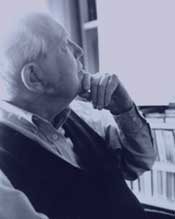Carter interview about Cello Concerto for Yo-Yo Ma

Elliott Carter discusses his new Cello Concerto, receiving its premiere in Chicago on 27 September, and his new Oboe Quartet, part of a major Carter feature at this summer’s Lucerne Festival
Your output suggests a particular fascination with concerto form. The recent Asko Concerto explored the baroque understanding of the form, but in the new Cello Concerto you seem engaged in the more familiar opposition between a soloist and the orchestra.
What has always interested me in my concertos are the possibilities for strong contrasts. That’s the same whether it’s between orchestral groups in the Concerto for Orchestra, between a pair of soloists in the Double Concerto, or between a single soloist and the orchestra as here. But I’ve never been that interested in the old-fashioned style of concerto where the orchestra picks up the same material as the soloist and treats it symphonically.
The cellist leads from the start in an introductory Drammatico. How does the soloist’s relationship with the orchestra develop throughout the continuous flow of the piece?
They’re at their maximum point of violent opposition at the start, where the cellist plays a long line and the orchestra doesn’t provide an accompaniment at all, just occasional, sharp, marked chords. Then there’s an Allegro appassionato with the cello playing with intensity and warmth while the interjections from the orchestra are more extended and mainly for woodwind with some brass. Then there’s a curious Giocoso which is largely a duet between cello and light, delicate percussion such as woodblocks. The central Lento has the cello starting down on the C string, with a long line gradually rising up through its full register. The Maestoso has the cello in dialogue with heavily accented brass. Then another unusual duet, this time a Tranquillo between high cello with lots of harmonics and a contrabass clarinet, which leads to the final section of the piece.
This last section returns to the opening tempo of the work, but also seems to provide a summing up for the work as a whole.
Well, even in the opening section there are hints of material that will appear in the final Tempo Primo, such as the left hand pizzicato writing in the soloist’s part. Also there are short episodes which lie between the main movements and they also point towards the final section. It’s here the big tutti climax comes before the orchestra leaves the cello alone again at the end.
There is a strong linear aspect to the work, rather as with your Violin Concerto. Is this influenced by the special singing quality of solo string instruments?
No, not really. I think my Oboe Concerto and Clarinet Concerto are just as linear and this is something I try to do in all my pieces, generally avoiding things being too fragmentary. The challenge I’m always faced with in writing solo parts is trying to give the player lyrical lines while also providing brilliant, virtuosic sections and inventing passages characteristic of the instrument. The cello does however have special qualities, particularly its enormous range, and its warmth, even more than the violin.
But the cello’s sound does pose particular challenges in terms of balance. How did you approach the orchestration in this work?
Well, you know the main problem is that the register of the cello is the same as that of the main body of the orchestra. It can’t always float above it like a violin, and so it’s not always easy to hear the soloist. Whenever the Dvorák Cello Concerto’s done, the orchestra is always told to play down. So, if the cello’s on the go a lot of the time, like here, you have to find various ways to solve this problem. I sometimes give the orchestra fewer notes so it’s more like chamber music, or when the cello’s playing legato I give the orchestra staccato notes, or sometimes I make the soloist and orchestra play in different registers.
Did you incorporate certain qualities of Yo-Yo Ma’s playing style and timbre?
I must admit we didn’t consult each other much by phone or letter, but I’ve known his style for a long time, because I’ve heard him play my Cello Sonata brilliantly many times in concert, and I’ve listened to him on disc. I love his beautiful sound and wanted to show what he could do - on all four strings. I don’t think the solo part is that hard, but we’ll see...
Another artist you have worked with extensively is the oboist Heinz Holliger. Can you tell us about the new Oboe Quartet that will be premiered at the Lucerne Festival on 2 September?
The piece is built up from a series of six duets, which cover every possible combination of the four instruments. Each duet lasts just a minute or two, and the other two instruments provide an accompaniment. When I wrote the Oboe Concerto for Heinz Holliger he showed me the amazing things he could do, such as multiphonics and glissandi, and I incorporated them into the concerto. But this new piece doesn’t have any of those sounds in it. My works now are not really experimental in terms of special effects but rather in the way the music is organised. Like with the Cello Concerto, doing a duet between cello and percussion - that was new for me and the sort of thing that really interests me.
Interviewed by David Allenby
Cello Concerto (2000)
3(III=picc).2.corA.2(II=bcl).bcl(=dbcl).2.dbn—4.3.3.1—
timp.perc(3)—harp—strings
Duration: 20 minutes
Premiere: 27/28/29 September 2001, Chicago
also 28 October, Carnegie Hall, New York
Yo-Yo Ma/Chicago Symphony Orchestra/Daniel Barenboim
Oboe Quartet (2001)
for oboe, violin, viola and cello
Duration: 17 minutes
Premiere: 2 September 2001, Lucerne Festival
Heinz Holliger/Thomas Zehetmair/Ruth Killius/Thomas Demenga
Other Carter works at Lucerne Festival (15 August - 15 September) include:
Partita, Allegro Scorrevole, Asko Concerto, Oboe Concerto, Quintet for Piano and Winds, Quintet for Piano and Strings
> Further information on Work: Cello Concerto
Photo: Elliott Carter © Meredith Heuer
